“Double, double, toil and trouble/Fire burn and cauldron bubble” .. We couldn’t think of anything else when ice started pouring from the sky, while mud was boiling from the ground.

First attempt to stroll around Mud Volcano in the Yellowstone NP ended up with us rushing back to the car when the hail start pouring heavily from nowhere. We were sure that somehow, the place has a spell! But later in the evening our host told us that hail is a common form of precipitation in the area.

One of the 10,000+ thermal features in Yellowstone, Mud Volcano area is one of the most acidic feature in the park, the heavy sulphur smell hits you once you approach the pots. This acidic features with limited water help the microorganism decompose the rock into clay and mud.
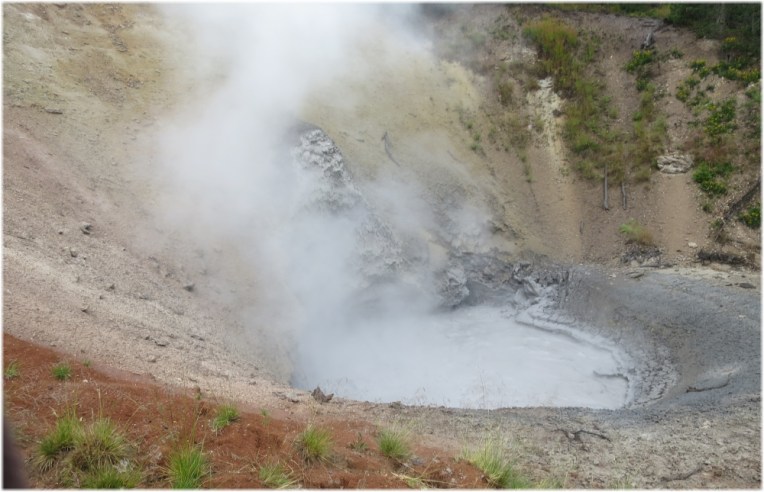
Mud Volcano was totally different in 1870, when had a cone-shaped mud deposit covering this feature. A thermal explosion has blown that mud away in 1872, to leave what we see today.
Two trails offer visitors options to see more or less of these features, however the short one passes these two notable landmarks: Mud Volcano, and Dragon’s Mouth Spring.


The suggestive name for Mammoth Hot Spring might give you an idea of what this is about. But you can only see with your own eyes these magnificent terraces, a natural and alive monument that changes shape and colors every day. One of the largest sources of travertine, this chalky white mineral amazes visitors with the hundreds of little terraces where the water falls in cascades. This is due to the thermal water that dissolves the limestone (calcium carbonate) when is heated and rises from below the surface. Sometimes the water concentrate in a few springs, but sometimes just flow over the terraces, creating little pools and ponds. Scientists estimate that at any time, only 10% of the water is on the ground, the other 90% is underground. They still continue to study where the heat comes from, if it’s from the volcano magma chamber (since the Mammoth Hot Springs are far North of the Yellowstone caldera), or there are some basaltic magma bodies deep underground between Norris and Mammoth.

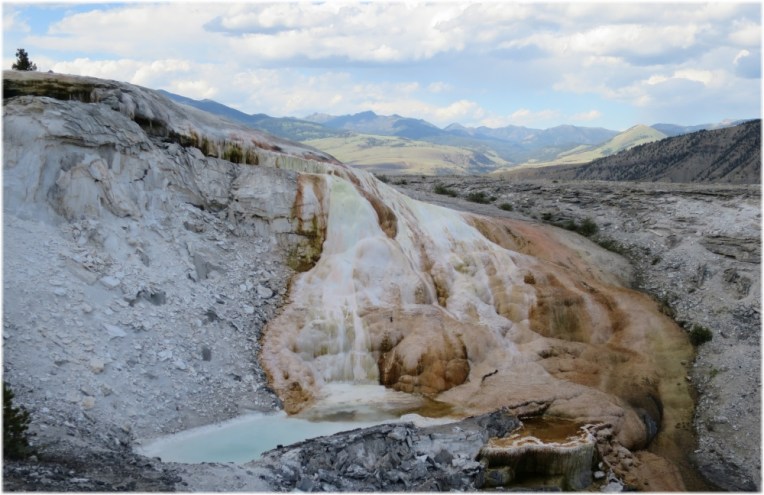
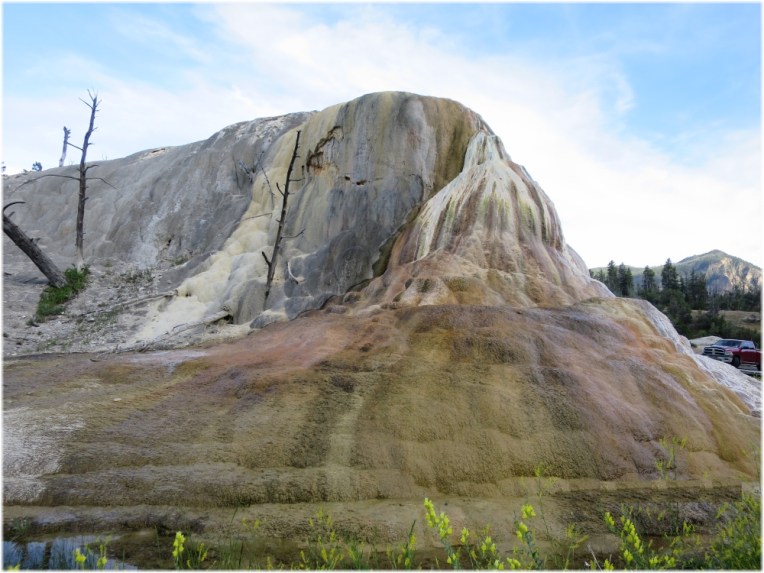
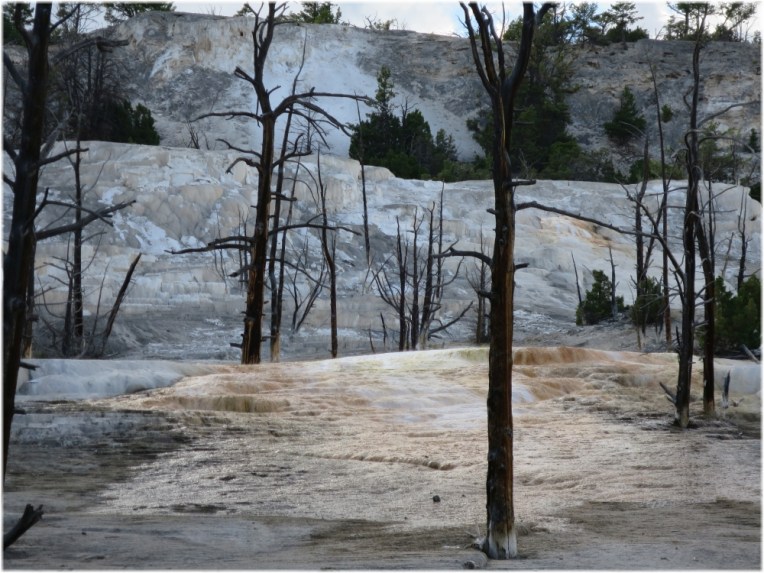
The springs greeted us with a smiling sun setting over the hill,

but actually the moment I fell in awe was the next morning, when we actually took the time to walk the Upper Terraces.

The terraces have been filled by the spring for many years, and even though due to the recent earthquake activity the spring vent has shifted, and the terraces went dry, back in 2016 when we visited the park, the terraces were still full of alive and vivid colors. There were many times when the terraces went dry in the past, and hopefully they will be filled again for people pleasure and delight once the spring vent will shift back or another vent will be created.


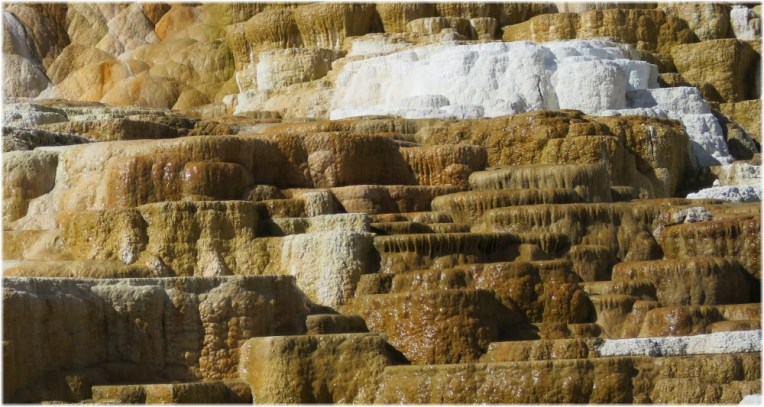
Norris Geyser Basin, the hottest and most changeable thermal area in Yellowstone is actually split in 2 basins: Back Basin and Porcelain Basin. Porcelain Basin is open terrain with hundreds of densely packed geothermal features; in contrast, Back Basin is forested and its features are more scattered and isolated. Unlike most of other geyser basins in the park, the waters from Norris are acidic, rather than alkaline.
Back Basin
The 8 meter deep pool of Emerald Spring is lined with yellow sulfur deposits, which hit us as soon as we got into the view of the spring. The blowing wind made it worse, as all the smell was directed right in our faces. I found that the pool was rather blue than emerald green as they say supposed to be, but probably it was just the instant reflection of that time of the day. And even though the clear blue reflected in our eyes was magnificent, we had to move on quickly, to be able to survive without oxygen masksJ
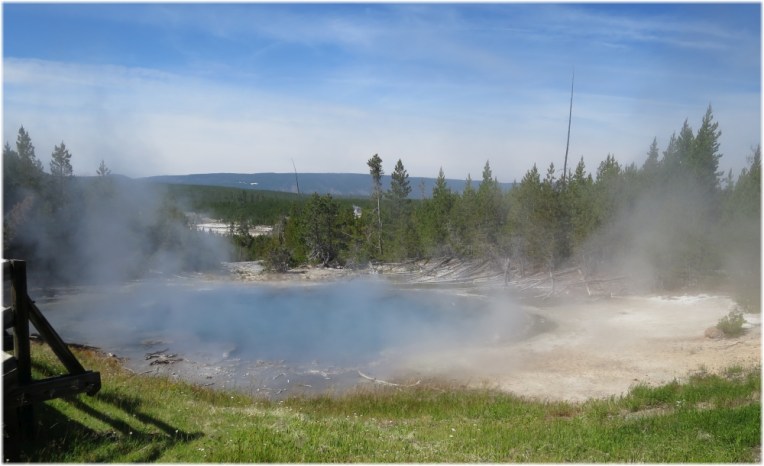
Suggestively named, Steamboat Geyser is the world’s tallest active geyser. Its major eruptions can shoot water more 91 m. We were not so lucky to see such show, but we got a glimpse of few good eruptions. The underground hissing and wheezing sounds of the water were a mesmerizing part of the show, as we’ve never figured out when and how tall the next eruption could be. Unlike the slightly smaller but much more famous Old Faithful Geyser located in Upper Geyser Basin, Steamboat has an erratic and lengthy timetable between major eruptions.

Porcelain Basin, with its emerald little ponds surrounded by the whitish, milky sandy surface, looks more like a wonderful beach. But don’t be fooled by this aspect. The surface can explode anytime, anywhere, creating a new feature. Many geysers have been born suddenly in small hydro-thermal explosions. Some features are ephemeral, their activity lasting a few hours, days, or weeks. Some others have become permanent.
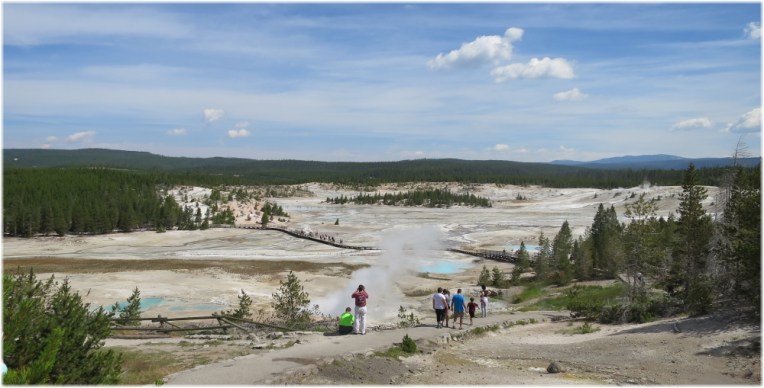
This basin is full of fumaroles (steam vents), which are the hottest features in the park, and also the reason everyone needs to walk on a boardwalk going around.
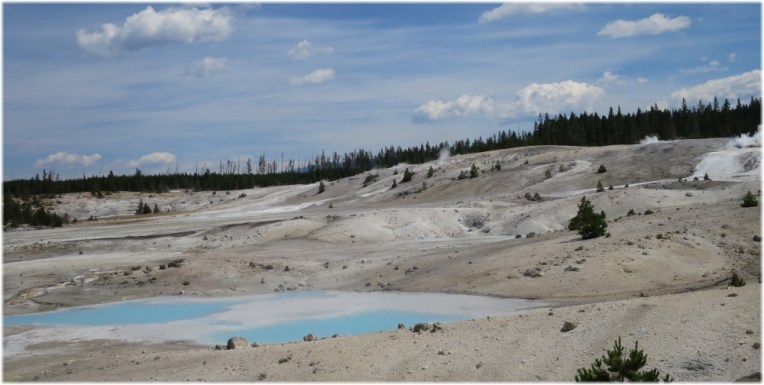
The milky mineral found in this basin (siliceous sinter) is brought to the surface by hot water and covering the area as the water flows across the ground and the mineral settles down.
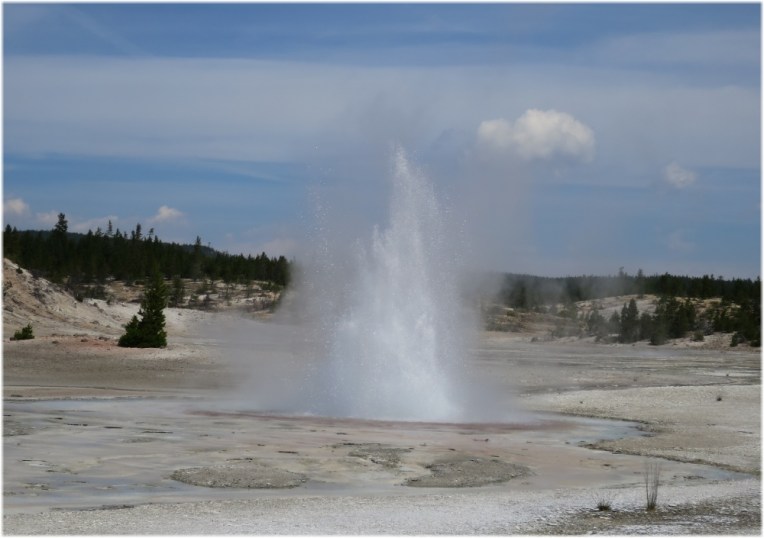
When the mineral seals off a hot spring or geyser by accumulating in its vent, the hot, pressurized water may flow underground to another weak area and blow through it, leaving behind empty, dry features.

The basin with the highest concentration of geothermal features in the park The Upper Geyser Basin is the home of Old Faithful, the most famous and celebrated geyser in the world. The Washburn Expedition in 1870 named it Old Faithful for its frequent and predictable eruptions.
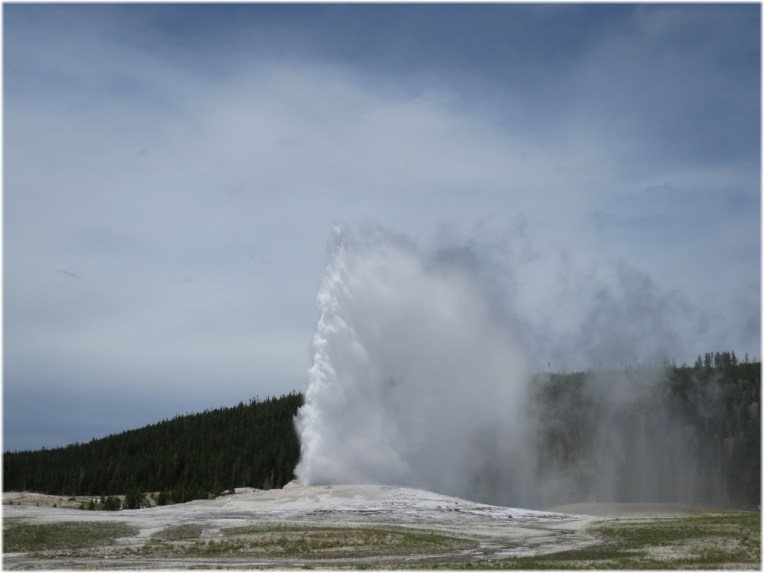
The average interval between eruptions is 90 minutes, enough time for a new crowd gathering to witness the majestic and consistent performance.

Despite its small size Midway Geyser Basin possesses two of the largest hot springs in the world. Grand Prismatic Spring, nearly 370 feet in diameter, sits upon a large mound surrounded by small step-like terraces. The other feature, Excelsior Geyser which is now a dormant geyser and is considered a hot spring. Other colorful springs include Turquoise and Indigo springs, known for their pale and dark blue colors.


- Runoff from Excelsior Geyser dumping in the Firehole River – Midway Geyser Basin
Grand Prismatic is the largest hot spring in Yellowstone (113 m diameter and 37 m deep), The Hayden Expedition in 1871 named this spring because of its beautiful coloration.

Turquoise pool – The 1878 Hayden Expedition named this pool for its milky, white bottom and gem-like, blue-colored water. Suspended mineral particles in the water also add an opalescent iridescence.
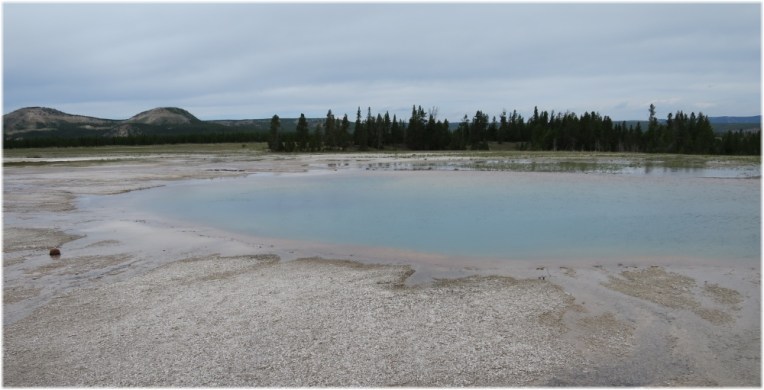
Thermophiles, or heat-loving microscopic organisms, are nourished by the extreme habitat at hydro-thermal features in Yellowstone NP. Seen everywhere in Yellowstone, Grand Prismatic Spring at Midway Geyser Basin is an outstanding example of this vast habitat for thermophiles. We could not but marvel at its size and brilliant colors. Nourished by energy, heat and chemical reactions, microbes build up multi colored communities. Species, unseen to the human eye, thrive in these acidic waters. Some create layers that look like molten wax on the surface of steaming alkaline pools. Some others exist only in the sulfuric cauldrons that stink worse than rotten eggs. Along the boardwalk we crossed so many colorful areas, and even though the wind blew sometimes the steam right in our faces, or the crowd was crossing our direction, we couldn’t stop to marvel at these picturesque, almost magical and special species that create unique landscapes, landscapes that can easily fit along with other highlights of the park into one of the seven natural wonders of our beautiful world.







Great photos and adventure. You brought us back to our September 2016 trip there.
LikeLiked by 1 person
Thank you! I guess every trip is a new adventure:)
LikeLiked by 1 person
It sure is Christie. Exciting!
LikeLiked by 1 person
I originally became attracted to these springs and pools with their unearthly colors in Iceland, but the ones here surpass them in their size and range of colors, I think. What a cool (not literally – haha) experience you had. I have not been to much of Yellowstone, and I’ve really got to do it justice someday. Great trip!
LikeLiked by 1 person
Thank you Lexi! I’ve heard that the ones in Iceland are famous too, hopefully in a couple of years will get there too:)
LikeLiked by 1 person
Your photos remind me of our trip to the natural parks around and in Rotorua, New Zealand. Amazing Nature shows!
LikeLiked by 1 person
Thank you Jadi! For sure Mother Nature is a gracious and amazing entity, even though sometimes it does unleash her fury (with a lot going on these days). I know there are amazing places in NZ, and one day I will see them with my own eyes.. one day:) Thank you for stopping by!
LikeLiked by 1 person
Excellent post, Christie. I spent a week in Yellowstone, and yet many of the highlights here were features I had not seen. You did a great job of extensively including many of the geothermal features, explaining the science of them, and photographing the raw beauty. This is one incredibly beautiful and unusual place on earth.
LikeLiked by 1 person
Thank you Jet! I think the nature has much more to offer for us to discover, even after an extended period. I wish myself to have stayed longer, but there is always something left for a next time
LikeLiked by 1 person